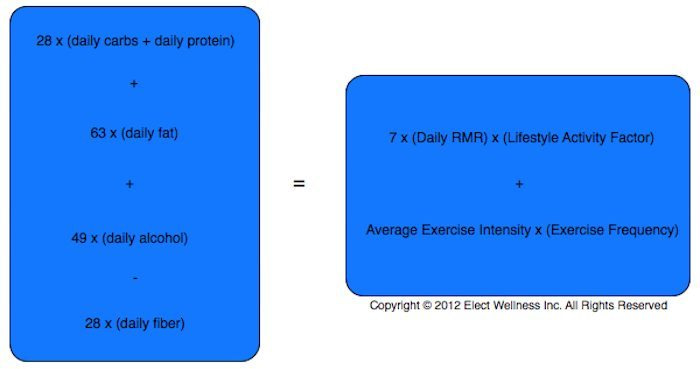You see all kinds of estimates on weight loss. It’s 50% diet, 50% exercise, or maybe it’s 25% diet, 75% exercise, and so on and so forth. Let’s examine the implications of those statements and come to a deeper understanding of what all affects our weight on a week to week basis. We are about to get technical, but stay with me through this detailed explanation and you at least won’t ever forget the point I’m making. Neither will you doubt it’s validity, and hopefully you’ll act on its truth.
Here’s the WEEKLY WEIGHT BALANCE EQUATION below (apart from the effects of water retention and the thermogenic effects of particular nutrients). Look at the formula below and think about it for a moment (I hope you haven’t forgotten algebraic terms).

Looking at the left side of the formula:
There are 4 calories in a gram of carbs, 4 in a gram of carbohydrate, 9 in a gram of fat, and 7 in a gram of alcohol. There are also 7 days in a week. Now look at the equation again and you should understand the 1st number of every term on the left side of the equation. The left side is your total “energy in.”
Considering the right side of the formula, now (energy out):
We all have an RMR, or resting metabolic rate, which is the number of calories your body would burn if you were seated in that chair all day long. This RMR is mostly due to your frame, muscle (just 1 of the reasons resistance training is important), and cardio conditioning, while only fractionally due to the amount of fat you are carrying.
Your Lifestyle Activity Factor is the % of calories above your RMR that you burn in your daily activities, outside of purposeful exercise. A construction worker’s LAF might be 80%, or RMR x 1.8, while a software engineer’s LAF might be 20%, or RMR x 1.2.
Your exercise intensity could be expressed by your average caloric burn per workout. For example, you estimate your burn with something like a heart rate monitor and total an average of 600 calories per 45 minute training session. Your exercise frequency, obviously, is the number of times in a week you do that exercise and burn those 600 calories.
Let’s bring this formula to life for a moment. Consider a typical 250 lb male eating 2500 calories a day. (if that sounds high, record your diet for a while and you might be surprised to see where you are at). If that person is eating the usual 15% protein, 35% fat, 45% carbs, 5% alcohol, and only 10g of fiber (like many of our clients when they start with us), here’s what their left side number equates to:
17,220 calories of “energy in”
Now if that same person has an RMR of 1700 and works in front of a computer all day long, while only exercising 2 days a week and burning 300 calories per session, their right side number equates to:
14,888 calories of “energy out”
That, my friends, yields:
2,332 calories to be stored WEEKLY
There are 3500 calories in a pound of fat, which means that this person would gain:
.67 pounds of fat gained per week, or 35 lbs in a year!
Let’s increase their exercise intensity to 500 per workout, and double their frequency to 4x / week. What do we get? An energy expenditure of 16,280, and a weekly extra 1392 calories to be stored:
.40 pounds of fat gained per week, or 21 lbs still gained in a year!
So what shall we do? Change our eating habits? Hek no! (an all too common answer – or, “I don’t eat that bad.”) Ok, let’s just workout 6 days a week, same new intensity. What do we get? An energy expenditure of 17,280, and a weekly BURN of 60 calories. Yeah! (read: sarcasm)
That’s a weekly weight loss of .01 lbs a week, or 1/2 a pound per year!! Excited yet?
I think you see my point. Why do you suppose so many are frustrated by the weight loss they see, or should I say don’t see, on exercise only programs?
The percentage of your weight loss that is due to eating right, and the % that is due to exercise, all depends on the depth of the changes you make in either arena. But I can tell you this, and you can SEE this now:
It is VERY DIFFICULT to change the scale on exercise alone!
So LET’S JUST SAY (read in Ron White’s voice) this person followed a more comprehensive approach and reduced their calories to 1800, making it easy by saying goodbye to alcohol most days of the week, tripling their daily fiber with quality carbs to stay full, and reducing their fat intake to 20% to make room for 35% protein. Let’s have them exercising just the minimum recommended MOST days of the week (that = 4). What does our math look like then?
11,760 energy calories in and 16,280 energy calories out, and
a weekly weight loss of 1.29 lbs per week, or 67 lbs lost in a year!
Now that’s something to get excited about :)



























